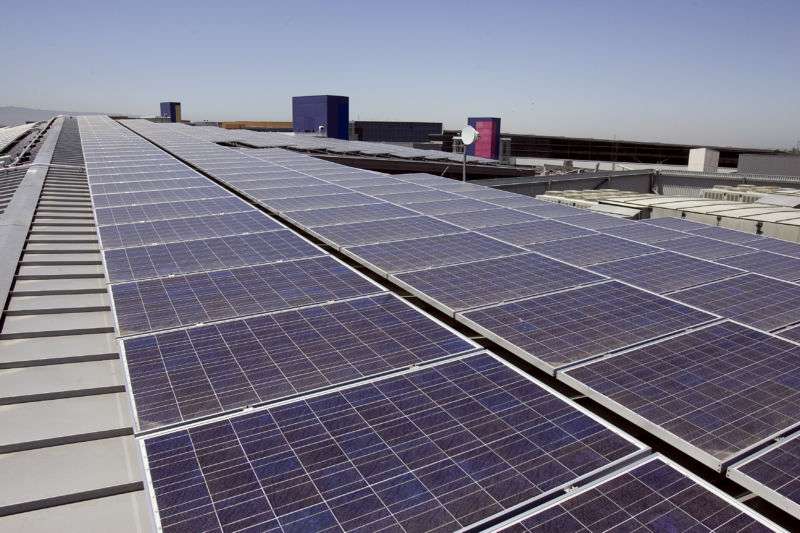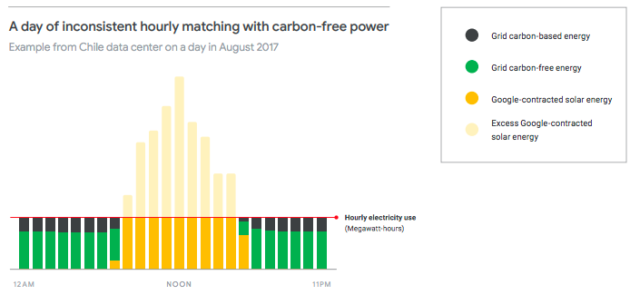
Five graphics from Google show how carbon-intensive its data centers really are

Google has long been a carbon-neutral company in a theoretical sense. That is, even when it’s physically impossible for Google’s data centers and offices to consume renewable energy, the company offsets that “dirty” energy with “clean” energy purchases at other times and locations.
The problem is, this does not make Google carbon-neutral in a practical sense, because the company still needs polluting energy sources to keep functioning. In a new report (PDF), Google has acknowledged this limitation and offered a few interesting graphics showing how much carbon-free energy its data centers actually consume.
The report is interesting not just because Google is the largest corporate buyer of renewable energy in the world but also because it shows Google is heading off criticism that has been lobbed at all kinds of corporate buyers of renewable energy, including major players like Facebook and Apple. That is, if you’re “offsetting” your carbon emissions by paying a wind farm owner for energy that’s created at 2am on land that’s 3,000 miles from your data center or factory, how much good have you really done?
In addition, there has been pushback from utilities that are concerned about the technical and financial aspects of corporate mandates to increase renewable energy sources.
Google contends that when it does buy renewable energy to compensate for the dirty energy it uses in another time and place, its purchases are a net benefit for the planet because it follows strict “additionality” standards. That is, Google “[seeks] to purchase energy from not-yet-constructed generation facilities that will be built above and beyond what’s required by existing energy regulations.” So even if the green energy isn’t serving Google’s data centers directly, it’s at least replacing conventional energy somewhere on the grid.
But what about carbon-free?
So why even bother working for an ideal, 24-hours-a-day, seven-days-a-week, direct-carbon-free energy profile if Google is already paying for renewable energy elsewhere? The company writes that its motivations are climate change and financial reliability. “[W]e strive to lead on climate change as a business imperative; we are a large electricity consumer that seeks to minimize our environmental footprint; and we are a growing business that prizes the cost-effectiveness and financial certainty of renewable power sources.”
The company recognized solar, wind, geothermal, hydropower, biomass, and nuclear energy in counting up hours of carbon-free energy provided to its data centers. The report includes local wind and solar installations that Google has directly contracted, as well as renewables on the local grid that Google didn’t have installed. Since it’s impossible to tell a renewable electron from a fossil-fuel-based electron, there’s obviously some estimation involved when Google takes energy from the local grid.
In this analysis, any excess energy produced by one of Google’s local wind or solar plants is not counted toward another hour if the wind or Sun cuts out and Google has to get energy from a fossil fuel plant in the next hour. 
In its report, Google offers a look at the energy consumption of five of its data centers from Finland (where 97 percent of its data-center consumption was “sourced” from renewable energy) to Taiwan (where only 16 percent of Google’s energy demand was matched with carbon-free sources).
-
Finland has significant nuclear and hydropower sources on its grid, and Google has signed several Power Purchase Agreements for renewable generation in the region, leading to a great carbon-free yearly profile.
-
At Google’s North Carolina data center, nuclear provides some 24-hour, carbon-free energy. An agreement with a solar plant also steps up Google’s carbon-free hours during the day.
-
In the Netherlands, Google’s agreement with a solar plant in the middle of the year helped make mid-day operations more carbon-free.
-
At Google’s Iowa data center, a new wind installation provides significant carbon-free electricity, but the company points out that a single renewable installation is not sufficient to cover all power needs, here specifically during periods of low wind.
-
Google’s data center in Taiwan was an example of a fossil fuel-dominant data center. The company says it is actively looking for opportunities to put more renewables on the local grid.
Going forward, Google says it wants to make the energy consumed by its less-green data centers greener and add more diverse types of carbon-free energy in places where there’s already a heavy penetration of renewables.
Part of that strategy is less about economics and more about politics. “In regions like Asia and the Southeastern US, the barriers to renewable energy development so far have not been technology or price but rather policy and market structure. This suggests a critical need to evolve utility regulation and energy business models at the state and regional levels.”
Google added that it is also looking to energy storage, advanced nuclear, and carbon capture and storage as potential ways to move past the variability of wind and solar plants. “Google is positioned to apply its expertise in resource efficiency and problem-solving strategies like machine learning to help advance the energy technology frontier,” the company wrote.




